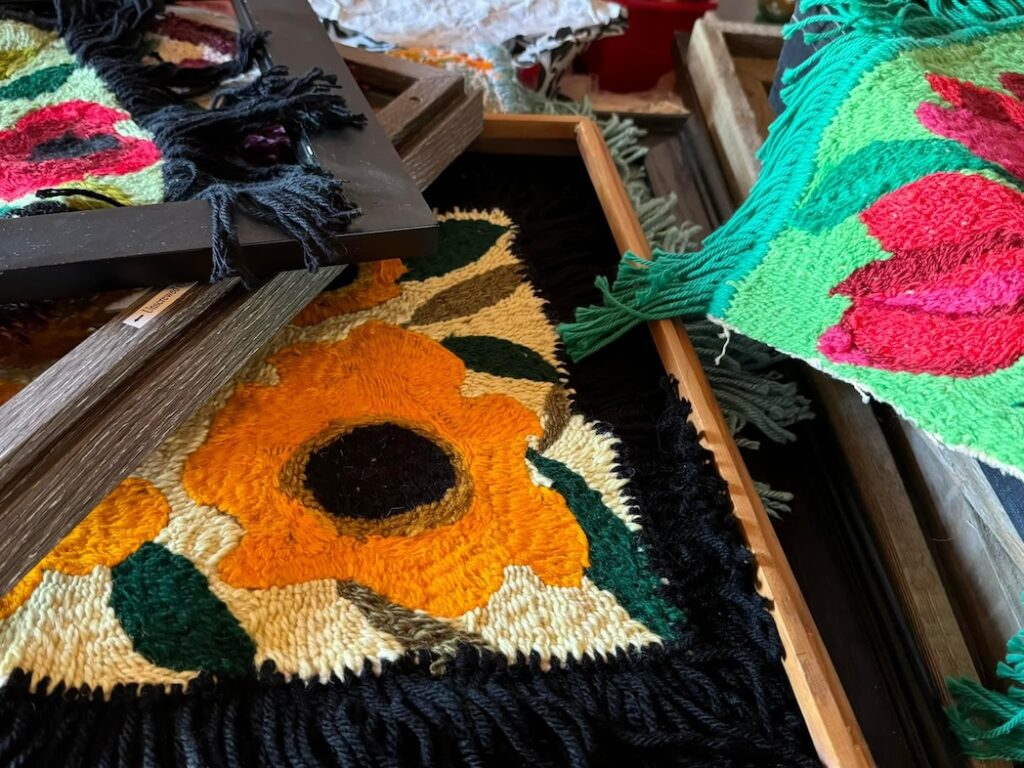If you grew up in one of the hamlets of southern Colorado or northern New Mexico, the word ‘colcha’ needs no explanation. But if you grew up in a more urban setting, in a place absent the Hispanic diversity that permeates these rural settings the word is very likely new to you. Colcha, for the record, is one of the country’s oldest artforms.
Colcha is the medium; the name derived from a stitch. It is an embroidery technique brought here by Spanish conquistadores. In its earliest incarnations, colcha often appeared as the artwork in New Mexican churches and missions. But it evolved, frequently becoming common as coverlet art.
Coverlets are more commonly known as bedspreads.
As a child, Colorado native Elaine Graves watched her mother and other older Hispanic women, including relatives, do colcha. Even today, there are regular gatherings in the tiny towns sprinkled across the Valley and northern New Mexico where colcheras meet to socialize and create this artform. These get togethers are a generational tradition interrupted only by weather or sickness.
But while watching her mother and others do this elaborate embroidery may have been something to do as a young girl, it wasn’t until she was grown that Graves gave serious thought to really learning the art.
After high school, Graves moved to Albuquerque for college. The New Mexico capital city is also where she began a career as a paralegal and private investigator. But it wasn’t until about twenty years ago as she was recovering from Lyme Disease, an illness that still lingers that Graves took a serious dive into this ancient artform.
While recovering and on a visit to her parent’s home, she recalled, “Mom said, ‘I’m going to teach you the colcha stitch.’” That’s all it took. Today, while modestly saying she’s still learning to master the stitch, Graves has gotten proficient enough that she’ll be part of a special arts event in Taos. On August 31st, Graves colcha will be part of a Wilder Nightengale Fine Art Museum showing in the New Mexico town. She calls it a ‘Meet the Artist’ show.
Locals and visitors, she said, will have the chance to “look at my work and I can tell them about colcha and its history.” Over the last twenty years and, of course, all the learning by osmosis from childhood, Graves has become somewhat of an expert colchera.

“Colcha,” she explained, “is a form of embroidery, a textile art.” As often as possible, Graves uses the same wool yarn as the region’s first colcha artists. That wool comes from the churro sheep also brought here by the Spanish.
Colcha might be considered primitive in that it employs traditional images and designs but is actually painstakingly sophisticated. Using the same wool and tools as the earliest colcha artists, people like Graves weave the most delicate images of birds, missions, store fronts and nature into their work.
The Graves’ Family has been part of the southern Colorado, northern New Mexico region going back multiple generations. In fact, she said the Graves family story is included as part of the Taos Historical Society archives.
The San Luis Valley native grew up on a farm, one where her father owned “a few hundred acres.” The main crop was alfalfa, she said, but there were also more than a few animals. “Dad worked the crops and sold hay bales all over New Mexico and Texas.” Incidentally, Graves said her father also knows colcha from his own Valley upbringing.
Despite arriving late in the game—compared to many other colcheras—Graves is serious about the skill and imagination that go into creating the art. “I am proud to be part of the new generation of colcheras and putting my mark out in Taos history.”
Graves remains almost embarrassed in calling herself an artist. But her upcoming Taos showing will not be her first. She has shown in other galleries and her work has received praise for its artistry.
“My pieces are different,” Graves said. “They tend to be a lot brighter. I use different kinds of yarn.” She also dyes her own wool creating her own unique hues that ultimately end up as the explosions of color animating, among other things, the flowers in her work. “How can I make it come to life through yarn,” she asks herself. Creating the vibrancy in her tones, she said, takes not just work but imagination. “It’s a lot different than painting a picture or taking a photograph. It’s instinct.”
Graves relies on the texture of the wool to grab someone’s attention. “I think I can use this chunky wool to capture the middle of the flower,” she explained. “It’s just fun to play with colors, and textures,” she said, her voice tailing off.
To see Graves’ work, you can visit elainegravescolchas.com. To get more information on her upcoming show, you can also visit the Wilder Nightingale Fine Art Museum at wnightingale.com. You can also call 575.758.3255


